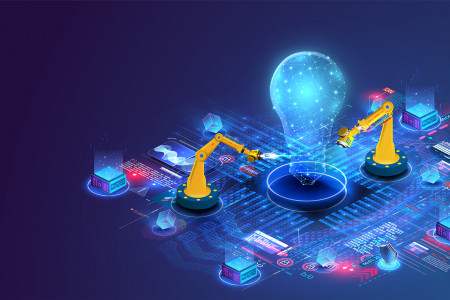What Should We Expect from Robots and AI in the Next Decade?
Autonomous mobile robots (AMRs) are already making significant headway across numerous industry sectors. In warehouses and facilities serving logistics, manufacturing, eCommerce, pharmaceuticals and biotech businesses, AMRs are being used to increase efficiency, flexibility and scalability on production lines and across factory floors.
The intelligence, machine learning capabilities, on-board sensors and intuitive navigation software of such systems enable autonomous robots to move dynamically, sense and manoeuvre around unexpected obstacles, and sort, pick and deliver with a higher level of accuracy than ever before.
Unlike automated guided vehicles or AGVs, AMRs do all this without direct driver input, pre-configured scripts or external infrastructure to free up resources, time and space within industrial environments. And that’s all thanks to artificial intelligence or AI and robotics! But what does the future of robots have in store for the suppliers of AMRs (like us) and the businesses they serve?
In this blog post, we delve deeper into the types of robots and automation to expect in the distant – and not so distant – future, how AI and robotics are used in business, and the advantages and disadvantages of using robots from industry to industry.
Types of Robots and Automation
What types of robots are used in business?
There are several types of robots and automation solutions serving the business world, each of which use AI and robotics in varying degrees. Robots have long been associated with automation to provide countless applications across a number of fields. Let’s start with a robot type that’s particularly close to our heart – the autonomous mobile robot or AMR.
As described above, AMRs use a series of sensors and cameras in conjunction with navigation algorithms, AI and robotics to make decisions as they go in real time. With this, they help industrial environments overcome numerous challenges and uphold high standards of safety across warehouses and other large scale facilities.
Automated guided vehicles (AGVs) play a similar yet more restrictive and infrastructure-heavy role. Instead of moving freely, they rely on tracks or pre-defined paths, using lasers, beacons, barcodes or magnetic tape to complete desired actions. Articulated robots, known widely as robotic arms, use AI and robotics to imitate the human arm. Robotic arms can complete a range of motions thanks to a selection of rotary joints. This ensures the accuracy necessary to undertake roles in arc welding, material handling, machine tending, picking, and packing.
Humanoids take these human-centric functions to a whole other level. Much like an AMR, humanoids can detect, plan and react to scenarios to provide appropriate actions in real time.
Whilst humanoids and AMRs work independently, ‘cobots’ function alongside or with humans to perform tasks. They share spaces and collaborate cohesively with workers to make manual, hazardous, tedious or strenuous tasks easier and safer. Hybrid robots provide the best of two or more robot types, combining their AI and robotics capabilities to tackle more complex tasks.
How have robots developed recently?
Whilst we can’t help but admire where the future of robots is heading, more recent developments in AI and robotics certainly deserve applauding. Cutting edge technology can be seen across multiple industries, with the latest innovations providing solutions for every sector.
Google’s worker robots recently hit the headlines thanks to their combination of AI and robotics. Boasting cloud-based systems and downloadable personalities, these patented bots support ultra-realistic interactions with humans. The technology giant isn’t the only major corporation to pioneer ambitious projects that have the potential to shape the future of robots. Momentum Machines has been working on a multi-tasking robot that you could just see in fast food outlets very soon. This robot can assemble a gourmet burger in less than 10 seconds!
In the manufacturing world, Universal Robots’ UR3 provides a collaborative system that promises to bring an even greater level of speed and precision to the production line. It’s nimble enough to complete dexterous tasks like gluing, painting, soldering and grasping. The innovative, table-top arm can even build its own replacement parts!
What types of industries use robots?
AI and robots have long been used across a number of industries to boost productivity and growth as well as make operations of all sizes and niches highly scalable. Industries that use robots include the industrial, military, service, exploration, healthcare, biotech, research and development, and entertainment sectors.
AI and robotics are proving particularly useful in hazardous environments too. Settings deemed too dangerous for humans to enter, such as disaster zones and high radiation areas, are being easily and safely negotiated by robots.
Advantages and disadvantages of robots?
With the future of robots being realised across many industries, those yet to introduce AI and robotics to their operations are certain to have a few questions. Many organisations will want to explore the advantages and disadvantages of robots before deciding whether to adopt such systems either en masse or a little more slowly.
Let’s begin with the advantages. Robots, including the autonomous mobile robot solutions we provide, can be used across many applications and situations to unlock a number of perks for company and customer. The speed and efficiency of robots mean greater productivity for organisations. Whilst the accuracy offered by many robot types guarantees the quality and consistency demanded by the consumers of today.
Robots can also be used to undertake tasks that are deemed too tedious or monotonous for human workers. More often than not they do so at an increased pace to ensure maximum output. As a result, the talents of human workers can be used to complete more rewarding activities elsewhere. The use of AI and robotics in the latest models make robots excellent choices for hazardous tasks or jobs that require the highest degree of accuracy. Unlike human workers, robots do not require specific environmental conditions either, leaving organisations spending less on lighting, air conditioning and noise pollution reduction measures.
Whilst emerging technology is paving the way for robots that outperform humans in (almost) every way, robots are still unable to improvise in the same capacity. For collaborative environments where robots and humans work in harmony, additional safety protocols will need to be put into place to protect your workforce.
The uptake of robots and other automated solutions across various industry sectors is also causing economic problems in many areas, with fewer manual jobs available for human workers. There are of course some roles that robotics can never fulfil, including teaching and caregiving jobs that require socioemotional skills.
Robots can be costly investments, but with the right uptake and continued maintenance, automated solutions provide excellent returns.
How We Expect Robots to Develop over the Next Decade
What is Robotics?
A question we’re often asked is “what is robotics?” and this can be answered rather succinctly. Robotics is the combination of engineering and computer science, the result of which is a device or machine that can perform programmed tasks with minimal or zero human intervention.
Robotics range from a simple, mechanical arm used to complete repetitive tasks on the assembly line right through to intuitively intelligent autonomous systems that detect and negotiate unexpected challenges and obstacles. The future of robots is even making the commercialisation of humanoids with personalities possible!
What is AI in relation to robotics?
Whilst often mentioned in the same breath, AI and robotics are fundamentally different. The past, present and future of robots however simply wouldn’t flourish without the use of AI.
AI or artificial intelligence is the design and development of systems that emulate the human mind. This enables them to learn from scenarios, solve challenges and make decisions just like you without specifically pre-programmed settings. Both AI and robotics coexist, coming together to make the resulting systems more sophisticated, intelligent and intuitive to ensure optimum success for the organisation they serve.
How is robotics expected to change over the next 10 years?
We’re in no doubt that AI and robotics will change the world. In fact, it has already altered the way we do things on a daily basis to enrich both our professional and personal lives. The use of AI and robotics is expected to revolutionise manual job roles during the next decade. According to this report, a decline of 18% in such roles is predicted by 2030 and a greater decrease of 28% in roles requiring basic cognitive skills has also been forecasted.
In the world of medicine, surgical robots are also expected to play starring, entirely independent roles in more precise procedures thanks to advances in AI.
Guidance Automation and AMRs
Guidance Automation is at the very forefront of AMR development. As a result, we continue to invest heavily in the development of AMR top modules for a wide range of bespoke applications to help organisations like yours reap all the rewards of going automated both now and in the future.
Conclusion on Robots and AI Moving Forward
As a leading provider of first class autonomous mobile robot (AMR) solutions, we’re lucky enough to be a part of an exciting, rapidly developing industry sector. The future of robots is looking brighter than ever, with the latest advancements in artificial intelligence and robotics set to pave the way for cutting edge technology in AMRs and other automated systems.
Embracing the future of robots within your organisation is simpler than you think and it all begins right here with our free AMR trial. As well as realising the benefits of AMRs at no additional cost and with no obligation, our free trial enables you to take those very first steps towards your own productive, scalable, safe and secure future with the help of AI and robotics.




